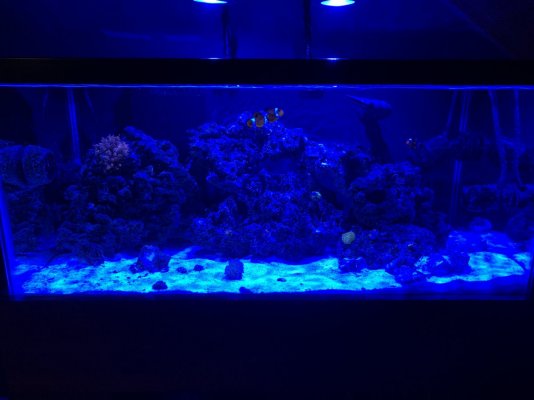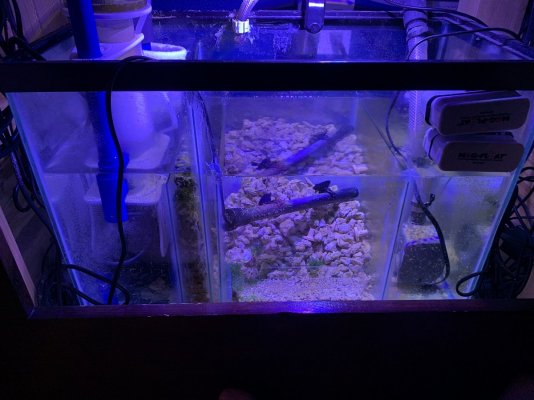Hello! Long time reader of reef2reef, first time poster. I know this has been asked a lot but I am running out of ideas and don’t know anyone else in my non-internet life that has a reef tank to ask about this.
I have a DIY drilled 40 breeder with a 20 gallon tall DIY sump/refugium that’s been up and running for 6 years. Admittedly, I neglected my maintenance last year and had a major cyano outbreak and lost all my corals. My only two fish I’ve ever had (two clowns) are still alive and doing well. I have been trying to get my tank back to great shape and have slowly been adding corals again; they are all doing very well. Still fighting the cyano a bit though, manually blow it off rocks before I do water change and suck as much out as I can. Have not done any chemiclean or other treatments for it, trying to do it naturally.
I have been struggling with high nitrates and can’t seem to lower them. My parameters are pretty steady at:
0ppm ammonia, 0ppm nitrites, 8.2 PH, ALK 7.2-8.0dkh, Calcium 500-550ppm, Mag 1400-1500, Phosphorous 0.02ppm, but my nitrates are ranging anywhere from 40-95 ppm. I have always used 0TDS RO/DI water and change all the filters as soon as it reads above 0TDS. I have been feeding pellets very lightly between once every two days and once every three days, only what the two fish eat. There might be two or three pellets they miss each feeding but I have some small bristle worms and nessarius snails to eat those I figure. I added a small bubble tip anenome a month ago and feed him once a week by mixing one cube of mysis with an appropriately sized dose of reef roids, broadcast feeding the rest of my corals whatever is left after he gets a good amount of food. The clowns eat all the remaining mysis. The anenome is very happy and has doubled in size since I’ve had him.
I run a cheap skimmer (that seems to be working) 24/7 and change my filter sock two or three times a week. I’ve been doing 20-25% water changes every week and sometimes twice a week for a few months trying to get the nitrates down. No luck. Not sure if relevant, but I also added miracle mud, a little chaeto and pods to my refugium two weeks ago.
Am I over thinking this trying to chase numbers too much? My corals seem happy, I just don’t want to ever lose any corals again because that was pretty depressing before lol. I had a few 15+ head frogspawn and hammers, which seem to be worth wayyy more money now than when I started six years ago. Do you guys have any advice for me?
Apologies for the long-winded post and thank you in advance for any responses and opinions you all may offer. Attached a pic of display tank and sump to give you all an idea of my set up. Don’t know what kind of filter you guys use to make it not look so blue so it is very blue looking in the pics lol.


I have a DIY drilled 40 breeder with a 20 gallon tall DIY sump/refugium that’s been up and running for 6 years. Admittedly, I neglected my maintenance last year and had a major cyano outbreak and lost all my corals. My only two fish I’ve ever had (two clowns) are still alive and doing well. I have been trying to get my tank back to great shape and have slowly been adding corals again; they are all doing very well. Still fighting the cyano a bit though, manually blow it off rocks before I do water change and suck as much out as I can. Have not done any chemiclean or other treatments for it, trying to do it naturally.
I have been struggling with high nitrates and can’t seem to lower them. My parameters are pretty steady at:
0ppm ammonia, 0ppm nitrites, 8.2 PH, ALK 7.2-8.0dkh, Calcium 500-550ppm, Mag 1400-1500, Phosphorous 0.02ppm, but my nitrates are ranging anywhere from 40-95 ppm. I have always used 0TDS RO/DI water and change all the filters as soon as it reads above 0TDS. I have been feeding pellets very lightly between once every two days and once every three days, only what the two fish eat. There might be two or three pellets they miss each feeding but I have some small bristle worms and nessarius snails to eat those I figure. I added a small bubble tip anenome a month ago and feed him once a week by mixing one cube of mysis with an appropriately sized dose of reef roids, broadcast feeding the rest of my corals whatever is left after he gets a good amount of food. The clowns eat all the remaining mysis. The anenome is very happy and has doubled in size since I’ve had him.
I run a cheap skimmer (that seems to be working) 24/7 and change my filter sock two or three times a week. I’ve been doing 20-25% water changes every week and sometimes twice a week for a few months trying to get the nitrates down. No luck. Not sure if relevant, but I also added miracle mud, a little chaeto and pods to my refugium two weeks ago.
Am I over thinking this trying to chase numbers too much? My corals seem happy, I just don’t want to ever lose any corals again because that was pretty depressing before lol. I had a few 15+ head frogspawn and hammers, which seem to be worth wayyy more money now than when I started six years ago. Do you guys have any advice for me?
Apologies for the long-winded post and thank you in advance for any responses and opinions you all may offer. Attached a pic of display tank and sump to give you all an idea of my set up. Don’t know what kind of filter you guys use to make it not look so blue so it is very blue looking in the pics lol.















